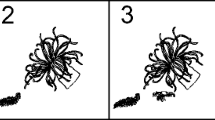Abstract
Under the general heading of symbiosis, defined originally to mean a “living together” of two dissimilar species, exist the sub-categories of mutualism (where both partners benefit), commensalism (where one partner benefits and the other is neutral) and parasitism (where one partner benefits and the other is harmed). The sea anemone-fish (mainly of the genus Amphiprion) symbiosis has generally been considered to benefit only the fish, and thus has been called commensal in nature. Recent field and laboratory observations, however, suggest that this symbiosis more closely approaches mutualism in which both partners benefit to some degree. The fishes benefit by receiving protection from predators among the nematocyst-laden tentacles of the sea anemone host, perhaps by receiving some form of tactile stimulation, by being less susceptible to various diseases and by feeding on anemone tissue, prey, waste material and perhaps crustacean symbionts. The sea anemones benefit by receiving protection from various predators, removal of necrotic tissue, perhaps some form of tactile stimulation, removal of inorganic and organic material from on and around the anemone, possible removal of anemone “parasites”, and by being provided food by some species of Amphiprion.
Similar content being viewed by others
Literature cited
Abel, E. F.: Zur Kenntnis des Verhaltens und der Ökologie von Fischen an Korallenriffen bei Ghardaqa (Rotes Meer). Z. Morph. Ökol. Tiere 49, 430–503 (1960a).
—: Ein Beispiel für die räumliche Orientierung von Amphiprion percula (Lac.). Pyramide 3, 78–79 (1960b).
Allee, W. C., D. Park, A. E. Emerson, T. Park and K. P. Schmidt: Principles of animal ecology 837 pp. Philadelphia: Saunders Co. 1949.
De Bary, A.: Die Erscheinung der Symbiose, 243 pp. Strasbourg: Trübner 1879.
Bowman, T. E. and R. N. Mariscal: Renocila heterozota, a new cymothoid isopod, with notes on its host, the anemone fish, Amphiprion akallopisos, in the Seychelles. Crustaceana 14 (1), 97–104 (1968).
Coates, C. W.: Safe hiding places moved while you wait. Anim. Kingd. 67, 77–79 (1964).
Crespigny, C. C. De: Notes on the friendship existing between the malacopterygian fish Premnas biaculeatus and the Actinia crassicornis. Proc. zool. Soc. Lond. 1869, 248–249 (1869).
Eibl-Eibesfeldt, L.: Beobachtungen und Versuche an Anemonenfischen (Amphiprion) der Malediven und der Nicobaren. Z. Tierpsychol. 17 (1), 1–10 (1960).
Fishelson, L.: Observations and experiments on the Red Sea anemones and their symbiotio fish Amphiprion bicinctus. Bull. Sea Fish. Res. Stn Haifa 39, 1–14 (1965).
Gohar, H. A. F.: Partnership between fish and anemone. Nature, Lond. 134, 291 (1934).
—: Commensalism between fish and anemone. (With a description of the eggs of Amphiprion bicinctus Rüppell). Publs mar. biol. Stn Ghardaqa 6, 35–44 (1948).
Graefe, G.: Zur Anemonen-Fisch-Symbiose, nach Freilanduntersuchungen bei Eilat/Rotes Meer. Z. Tierpsychol. 21 (4), 468–485 (1964).
Henry, S. M. (Ed.): Symbiosis. Vol. I. Associations of micro-organisms, plants and marine organisms, 478 pp. New York: Academic Press 1966.
Herre, A. W.: Some habits of Amphiprion in relation to sea anemones. Copeia 1936 (3), 167–168.
Holthuis, L. B.: The Decapoda of the Siboga Expedition. Part 9. The Hippolytidae and Rhynchocinetidae. Siboga Exped. 39a (8), 1–100 (1947).
—: The Decapoda of the Siboga Expedition. Part 11. The Palaemonidae II. Subfamily Pontoniinae. Siboga Exped. 39a (10), 1–254 (1952).
Humes, A. G.: New species of Lichomolgus (Copepoda, Cyclopoida) from sea anemones and nudibranchs in Madagascar. Cah. océanogr. ORSTOM 6 (Série Nosy-Bé), 59–130 (1964).
Jacquotte, R.: Notes de faunistique et de biologie marines de Madagascar. 1. Sur l'association de quelques crustacés avec des cnidaires récifaux dans la région de Tuléar. Recl Trav. Stn mar. Endoume 32 (48), 175–178 (1964).
Koenig, O.: Verhaltensuntersuchungen an Anemonenfischen. Pyramide 8 (2), 52–56 (1960).
Ladiges, W.: Das Rätsel der Symbiose zwischen den Riesenseerosen der Gattung Stoichactis und den Fischen der Gattungen Premnas und Amphiprion. Wschr. Aquar.- u. Terrarienk. 46, 669–676 (1939).
Mariscal, R. N.: The symbiosis between tropical sea anemones and fishes: a review. In: The Galápagos, pp 157–171. Ed. by R. I. Bowman. Berkeley: University of California Press 1966a.
Mariscal, R. N.: A field and experimental study of the symbiotic association of fishes and sea anemones. Doctoral Diss., University of California, Berkeley. Ann Arbor: University Microfilms 1966b.
Mariscal, R. N.: The symbiotic behavior between fishes and sea anemones. In: Behavior of marine animals — recent advances, Ed. by H. E. Winn and B. Olla. New York: Plenum Publishing Corporation. (In press).
Moser, J.: Beobachtungen über die Symbiose von Amphiprion percula mit Aktinien. Sber. Ges. naturf. Freunde Berl. 1931 (2), 160–167 (1931).
Noble, E. R. and G. A. Noble: Parasitology. The biology of animal parasites, 2nd ed., 724 pp. Philadelphia: Lea & Febiger 1964.
Ross, D. M. and L. Sutton: Detachment of sea anemones by commensal hermit crabs and by mechanical and electrical stimuli. Nature, Lond. 217, 380–381 (1968).
Saville-Kent, W. S.: The Great Barrier Reef of Australia. 387 pp. London: W. H. Allen and Co. 1893.
Sluiter, C. P.: Ein merkwürdiger Fall von Mutualismus. Zool. Anz. 11, 240–243 (1988).
Smith, D., L. Muscatine and D. Lewis: Carbohydrate movement from autotrophs to heterotrophs in parasitic and mutualistic symbiosis. Biol. Rev. 44 (1), 17–90 (1969).
Verwey, J.: Coral reef studies. 1. The symbiosis between damselfishes and sea anemones in Batavia Bay. Treubia 12 (3–4), 305–366 (1930).
Weber, M.: Die Fische der Siboga Expedition. Siboga Exped. 57 (1913).
Whitley, G. P.: The fishes of Michelmas Cay, North Queensland. Rec. Aust. Mus. 16 (1), 1–32 (1927).
—: Some fishes of the order Amphiprioniformes. Mem. Qd Mus. 9 (3), 207–246 (1929).
—: Fishes. Brit. Mus. (Nat. Hist.) Scient. Rep. Gt Barrier Reef Exped. 4 (9), 267–316 (1932).
Yonge, C. M.: A year on the Great Barrier Reef, 246 pp. London: Putnam 1930.
Author information
Authors and Affiliations
Additional information
Communicated by G. L. Voss, Miami
Rights and permissions
About this article
Cite this article
Mariscal, R.N. The nature of the symbiosis between Indo-Pacific anemone fishes and sea anemones. Marine Biology 6, 58–65 (1970). https://doi.org/10.1007/BF00352608
Accepted:
Issue Date:
DOI: https://doi.org/10.1007/BF00352608




